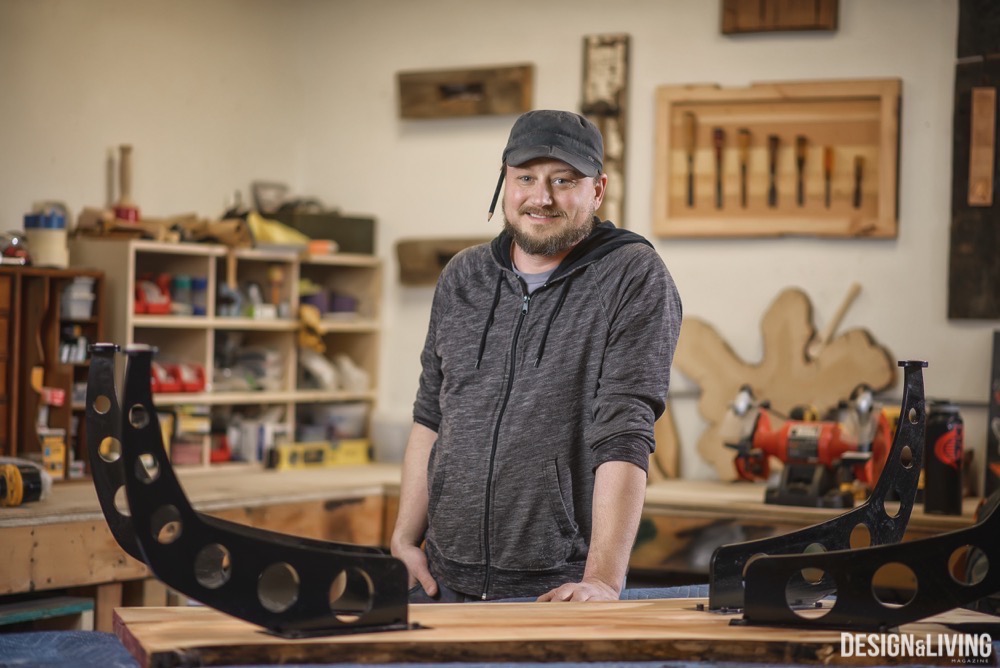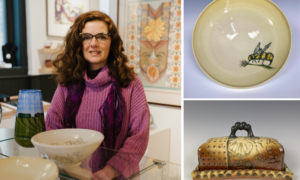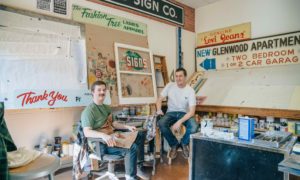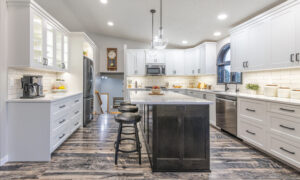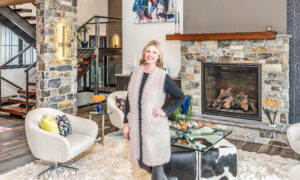PHOTOS BY J. ALAN PAUL PHOTOGRAPHY AND TOM KEMMER
Combining his love of art, music, skateboarding and woodworking, Tom Kemmer of Kemmco is quickly making a name for himself as one of the area’s first three-dimensional wall and furniture artists. Breaking the mold from a popular reclaimed wood wall trend, Kemmer takes his unusual practice of patterns and elevates them to new heights with walls that captivate the eye. Inside his Fargo shop, Kemmer took us on a tour of his latest furniture pieces and patterned wood art, then introduced us to an astonishing sight just beyond the shop’s walls.

The last time we stopped by the new Dakota Timber Co. shop in Fargo, we noticed an an intriguing design, something we’d never encountered in the hundreds of homes we’ve toured. Within the new showroom’s space was the most mesmerizing, reclaimed wood wall with a three-dimensional cube-like pattern. Always curious on the latest design trends, we had to find out just who had built this incredible wall and exactly how they built it.
Owner Seth Carlson directed us to Tom Kemmer of Kemmco. Newer to the business, Kemmer moved back to the area just five years ago after a stint living in the Twin Cities and most recently in the woods of Pine River.
Skateboard Inspired
Finding inspiration in the woods, Kemmer started building retro-style cruiser skateboards five years ago while living amongst the trees.

“That just kind of progressed,” said Kemmer. “My dad was a flooring contractor and so I would come back here and work with him and go back out to the woods. I was doing this back and forth trying to resist moving home,” laughed Kemmer.

Life in the woods for Kemmer meant hunting, fishing and smoking meat.

“We did a lot of foraging, there’s a lot of edible mushrooms out there. We had a nice section of land on the Pine River and did whatever suited our fancy,” said Kemmer. These days, Kemmer has planted his roots in Fargo with his partner and their two children.

Once an art and photography student at MSUM, Kemmer has strong roots in music and skateboarding as well. However, it wasn’t until he crafted his own skateboard just a few years ago that he decided on his current calling of handcrafted furniture and reclaimed wood walls. His knowledge of art and symmetry combined with his past flooring experience proved to be the perfect combination for creation.
Creative Collaborations
This past year, Kemmer focused his attention on woodworking. With his dad now retired, he segments his time between reclaimed wood flooring and walls through Dakota Timber Co. and creating custom furniture pieces in his shop. Today, people contact him for virtually anything that requires woodworking with a little more creative expertise. “People call up and present ideas for furniture or flooring and we’ll usually do a few sketches based on the conversation,” said Kemmer.

These days Kemmer will build and install most anything when it comes to wood. “We do a lot of floors, furniture, bars, mantels, barn doors, case and base, along with some general contracting. I like collaborating, that’s one of the most exciting aspects of this,” said Kemmer. “When somebody tries to convey an image to you with words and you get to bring your take on it. It’s really organic, you get to bounce ideas off of each other. It reminds me of school, when you sit down and brainstorm and try to come up with something and make it the best it can be.”

“I love problem-solving with furniture because there’s tons of problems,” explained Kemmer. “How are we going to get this in the house? What if we made all the legs to come off and they were all the same plate so they could be interchangeable? We figure it out and work through them.”
Wall Illusions
When Dakota Timber Co. asked Kemmer to install a reclaimed wood wall, they had no idea how it would soon take on a life of its own. Originally planning on doing a more typical white-washed wood wall, the idea just didn’t seem novel enough for this new space. “We thought it might be too boring, but he wanted a clean design, so I said, ‘Let me sketch some stuff out’ and I researched geometric patterns and played around with them in here, making little swatches to figure out the angles and what our process would be,” explained Kemmer.

Reclaimed wood wall with three-dimensional, cube elements at Dakota Timber Co. in Fargo
“There was going to be a feature piece in the middle, but we decided to ditch that because it would be too distracting. We wanted the pattern to kind of take you. When you do that repetition and keep that consistency and your eyes aren’t able to focus on one thing, that’s when it really gets three-dimensional,” said Kemmer. “We incorporated more of what we did at Wild Bill’s (Sports Saloon) at the top where it breaks apart and deteriorates into various lines and cubes. It’s kind of like Tetris, where the pieces just fall into place. I wish it was that easy. It’s particularly difficult when it gets to the borders, then all your angles go crazy and it’s a lot more time consuming.”
For the Dakota Timber Co. wall, Kemmer worked three full days on it with a helper for two. “To put it into perspective, a more typical wall that size, if we were just doing a horizontal pattern, would take me about five hours by myself,” said Kemmer. With this game changing design a success, Kemmer is itching to try out one of his many other patterned and three-dimensional ideas. Now he’s just waiting for the next adventurous client that will give him the go-ahead.
Breaking the Mold
“My main idea with that wall was, let’s break the mold. 99 percent of these are done horizontal, they’re not mixing palettes, they’re doing burly and really one kind of style. I could probably put up a horizontal wall in my sleep,” said Kemmer. “From working in the cities, I am definitely used to clients that aren’t afraid of trying something new. I’m starting to see that more in this area. One of my clients here had me do an 18-foot fireplace surround for, the owner really thinks outside of the box. She used a white, a grey and a dark in hers. It almost has an eight-bit video game feel to it, with segmented lines. We did the corners in metal with old square-head bolts and floating shelves. ”

With a few other high-profile projects under his belt like his work at The Sanctuary and Wild Bill’s Sports Saloon, Kemmer is quickly becoming unanimous with creative spins on typical designs.

Wild Bill’s Sports Saloon became his first abstract wall design project using reclaimed wood in various textures and colors.

Mobile wet bar at The Sanctuary Events Center in Downtown Fargo

“That wall was completely free-form. She gave me one reference photo, it looked like a bedroom and it was just kind of beams and layering of wood in different depths, very three-dimensional,” said Kemmer. “I told her I couldn’t do it exactly like this, but I could do what’s in my head, a slightly different version of that.”

Reclaimed wood wall with three-dimensional elements at Wild Bill’s Sports Saloon in Fargo

For the wall at Wild Bill’s, Kemmer was given three kinds of wood to work with, a white-washed, grey and dark brown.

“Because I’ve always been intrigued with the lines of circuit boards and circuitry, if you look at the Wild Bill’s wall, you go in the there and follow the pattern and it kind of leads you through the whole thing, with lots of triangles too,” said Kemmer. “For this one, I had been watching a lot of Ancient Aliens and I think the idea of Illuminati, the pyramid with they eye was mimicked in this using a wood knot that was cut in a triangle. I like to feel it out as a go.”
Artful Appreciation
Having worked in the construction industry for most of his life, Kemmer can tell you that his focus now comes with a certain amount gratification. “I can’t say I enjoyed flooring as much as what I’m doing now. There’s awesome floors and you can do some really cool stuff with them, but 90 percent of them are the same old thing and people don’t really care. You’re just a guy crawling around on their floor,” said Kemmer. “When you build a piece of furniture for them, it’s just a different outcome. Their mind explodes and they’re wickedly grateful, and it makes you feel better at the end of the day. It’s great to know that they appreciate it. I like variety–I like to know that I’m not going to go to work everyday and do the exact same thing, that I’m going to get challenged.”

“One person brought in a giant grainery door and she wanted a dining room table made out of it. Every summer on the farm she had to white-wash that door, and now they’re tearing it down, so she wanted to do something with it,” said Kemmer. “Those kind of projects are awesome, it’s got history that’s personal to them and to her family. You take this big chunk of wood and two months later you have this modern-rustic dining table. Then I did a simpler design for a bench and a couple other end-tables for her siblings.
Shop Art
Whenever Kemmer finds himself lacking inspiration, he takes a look around his shop and searches for his next great pattern.

“When I’m in here and I’m sick of doing whatever I’m working on and I’m cutting a piece of wood and I see repetition or pattern, I’m attracted to that,” said Kemmer.

“So these laminate cuts, I started shaving a bunch off and you see this repeating pattern, so I do quick, little assemblages, little art pieces that get your mind off the real project. It kind of gives me a break and lets me come back to what I’m supposed to be doing.”
Getting Leggy
Referencing a piece of wood from down south, Kemmer explains that this finger-like growth of wood at the base inspired a series of leg designs.

This particular leg design was fabricated for his palm tree tables. “The idea was that they would possibly be plant stands or small end tables,” said Kemmer.

Showing us the array of steel legs in his wood shop, Kemmer said the idea behind them is that they’re all interchangeable and can be used with any type of top.
Modern Design versus Traditional Technique
This summer Kemmer has plans to start working on traditional woodworking techniques with a focus on mid century modern furniture. “This is kind of a melding of modern and rustic in some ways. I play a lot with steel and work on mid-century type of furniture and cabinetry and meld it all together,” said Kemmer.
Embracing Imperfections
While showing us his eclectic selection, Kemmer pointed out wood with origins from the Globe Mill in Superior, Wisconsin.

“When Seth at Dakota Timber Co. first started out, he was just down the road from us and he was getting a lot of this at the time. It’s pretty cool because it’s all cribbing,” said Kemmer. “You’ve probably seen the sections around town where they stack same size boards, nail it together, start with a 2×12, then go to a 2×10 every four feet or so. This wood kind of had a design that looked like the bottom of a river from all of the grain that washed down it. It also has really cool colors from grain and rust wear.”
Modern Design versus Traditional Methods
“All the people I’ve met, places I’ve traveled, it opened up a wide world that encompassed art, music and everything else. That’s skateboarding’s fault,” laughed Kemmer. Last Summer, he spent time in London working on a film, but his travels to Japan a few years back were his favorite.

“It’s just such a culture shock. I’d like to go back and befriend carpenters there, they do woodworking on a totally different level. I’ve been watching a lot of YouTube videos and traditional carpentry, getting away from the power tools. We live in a society that wants their project done now, a lot of that artisan work takes much more time. With traditional methods, it can take three months to build a rocking chair, but you’ll never have to buy another one and it will get passed down through the generations.”
Hawk’s Nest
Having visited countless shops and studios, we thought we’d seen it all. After a quick jaunt through the wood shop, Kemmer led us upstairs to show us a unique space hidden behind the wall, but well-known by those who matter the most to him. Kemmer created the Hawk’s Nest, an indoor skatepark that hosts The Fargo Skateboarding Cooperative, which was founded in 2011. “I lived in Minneapolis-St. Paul for about ten years playing music and making art, and there’s a couple places like this in the cities and I was lucky enough to be part of that,” said Kemmer. “So, when I moved back I decided I wanted to do that here.”

Kemmer and the co-op have hosted fundraisers called the Clean Skate Project, where artists from Fargo to Minneapolis contribute their time to designing and painting old skateboards that were raffled off to benefit the co-op’s operational costs.

Peering over the ledge of the upstairs loft, we were left gaping at the massive skatepark Kemmer had hand-built and designed over six months. As we left the loft area and headed down another staircase, we stood at the bottom of the skatepark where we were able to take in the full expanse of his custom creation.

Upstairs, Kemmer, a prior MSUM art and photography student is also working on creating more office space for his business as well as a printmaking and music studio. Kemmer has been a drummer in multiple bands, but claims his most successful venture was with a band called The Danforths, comprised of all MSUM students.

Kemmco
302b 39th St. N, Fargo
651-402-2061
[email protected]
facebook.com/kemmco

